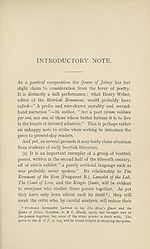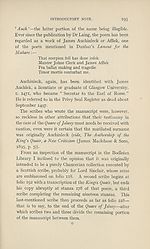Download files
Complete book:
Individual page:
Thumbnail gallery: Grid view | List view

INTRODUCTORY NOTE.
192
strange grammatical forms to order, and in that way seek
to explain the presence of many Midland and Southern
inflexions engrafted on poems written by men whose
native speech was the dialect of Lowland Scotland.
The relationship of The Court of Love, the Kingis Quair,
and the Quare of Jelusy to Lydgate’s Temple of Glas,
and to each other, is another interesting study for the
plodding investigator.
(2) The use of final e as a distinct syllable in Scottish
versification has been assumed by some modern editors
who have been misled by certain analogies from English
poems of the Chaucerian and post-Chaucerian age. By
the same line of reasoning several instances of that highly
artificial syllable would be postulated in the case of the
Quare of Jelusy {vide lines 17, 63, 67, 101, 119, 138, 300,
533). When, however, due value is given to the vowel
sounds of Lowland Scottish, perfect scansion is obtained
without the necessity for the sounding of any final e, the
simple explanation being that north of the Tweed words
like new, strong, schdrp, sene, hert, old, nyce, were, and are
to this day, often pronounced as dissyllables as indicated
by the diaeresis. Innumerable instances of such dissyllabic
use of words, seemingly monosyllabic to uninitiated readers
of Wyntoun, Barbour, Blind Harry, Henryson and other
early Scottish poets, might easily be cited.
(3) The Quare of Jelusy occurs on folios 221-228 of the
well-known Selden MS., B. 24. No other text is extant
at the present day. It was printed in the Bannatyne
Miscellany (Vol. IT, p. 161) from a transcription made
by the late Dr David Laing. That printed version was
collated with the manuscript by Miss Angelina F. Parker
of Oxford, and numerous mistaken readings corrected.
The colophon, it will be observed, ascribes the poem to
192
strange grammatical forms to order, and in that way seek
to explain the presence of many Midland and Southern
inflexions engrafted on poems written by men whose
native speech was the dialect of Lowland Scotland.
The relationship of The Court of Love, the Kingis Quair,
and the Quare of Jelusy to Lydgate’s Temple of Glas,
and to each other, is another interesting study for the
plodding investigator.
(2) The use of final e as a distinct syllable in Scottish
versification has been assumed by some modern editors
who have been misled by certain analogies from English
poems of the Chaucerian and post-Chaucerian age. By
the same line of reasoning several instances of that highly
artificial syllable would be postulated in the case of the
Quare of Jelusy {vide lines 17, 63, 67, 101, 119, 138, 300,
533). When, however, due value is given to the vowel
sounds of Lowland Scottish, perfect scansion is obtained
without the necessity for the sounding of any final e, the
simple explanation being that north of the Tweed words
like new, strong, schdrp, sene, hert, old, nyce, were, and are
to this day, often pronounced as dissyllables as indicated
by the diaeresis. Innumerable instances of such dissyllabic
use of words, seemingly monosyllabic to uninitiated readers
of Wyntoun, Barbour, Blind Harry, Henryson and other
early Scottish poets, might easily be cited.
(3) The Quare of Jelusy occurs on folios 221-228 of the
well-known Selden MS., B. 24. No other text is extant
at the present day. It was printed in the Bannatyne
Miscellany (Vol. IT, p. 161) from a transcription made
by the late Dr David Laing. That printed version was
collated with the manuscript by Miss Angelina F. Parker
of Oxford, and numerous mistaken readings corrected.
The colophon, it will be observed, ascribes the poem to
Set display mode to: Large image | Zoom image | Transcription
Images and transcriptions on this page, including medium image downloads, may be used under the Creative Commons Attribution 4.0 International Licence unless otherwise stated. ![]()
| Publications by Scottish clubs > Scottish Text Society publications > Third series > Miscellany volume > (208) |
|---|
| Permanent URL | https://digital.nls.uk/106934053 |
|---|
| Description | A collection of over 100 Scottish texts dating from around 1400 to 1700. Most titles are in Scots, and include editions of poetry, drama, and prose by major Scottish writers such as John Barbour, William Dunbar, Gavin Douglas, and George Buchanan. Edited by a key scholarly publisher of Scotland's literary history, and published from the late 19th century onwards by the Scottish Text Society. Available here are STS series 1-3. |
|---|

